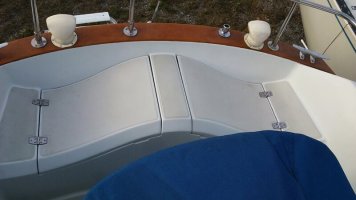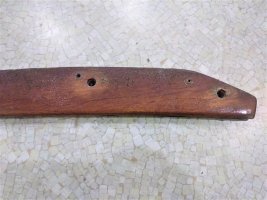I've never worked with Cetol before, so it's a bit of a mystery to me. I'm pretty sure my handrails and taffrail are Cetol treated from their orange-ish appearance. I actually don't mind the look. Not as nice as a quality varnish job perhaps, but I still prefer it to gray weathering.


As you work towards my companionway, the finish seems to shift to varnish--the hatchboards, the trim on the companionway hatch, etc. It's this piece that goes above the sliding companionway hatch I'm not sure about:


I'm thinking it might be Cetol becuase of the way it cracked/crazed in almost a grid-like pattern. It's also apparent that different coatings were used in different places (notice the discoloration around all the screw/bung holes). I removed the piece and sanded it thoroughly but it seems the wood still has a bit of an orange-ish tint to it (versus the non-coated side which sanded down to a normal brown-ish teak). Does Cetol penetrate that deeply into the wood that it would still be evident after sanding? Does this mean I have to use Cetol again, or can varnish be applied after sanding off Cetol? Is Cetol a time-saver over the years versus varnish?
Thanks.


As you work towards my companionway, the finish seems to shift to varnish--the hatchboards, the trim on the companionway hatch, etc. It's this piece that goes above the sliding companionway hatch I'm not sure about:


I'm thinking it might be Cetol becuase of the way it cracked/crazed in almost a grid-like pattern. It's also apparent that different coatings were used in different places (notice the discoloration around all the screw/bung holes). I removed the piece and sanded it thoroughly but it seems the wood still has a bit of an orange-ish tint to it (versus the non-coated side which sanded down to a normal brown-ish teak). Does Cetol penetrate that deeply into the wood that it would still be evident after sanding? Does this mean I have to use Cetol again, or can varnish be applied after sanding off Cetol? Is Cetol a time-saver over the years versus varnish?
Thanks.
Last edited:
